Microstructure Evolution and Fracture Mechanism of 55NiCrMoV7 Hot-Working Die Steel during High-Temperature Tensile
Abstract
1. Introduction
2. Experimental Materials and Procedure
2.1. Materials and Heat Treatment
2.2. Mechanical Properties
2.3. Characterization of Microstructure
3. Result and Discussion
3.1. High-Temperature Mechanical Properties of 55NiCrMoV7 Steel
3.2. High-Temperature Tensile Fracture Morphology
3.3. Effect of Tensile Temperature on Microstructure of 55NiCrMoV7 Steel
3.4. Precipitate Phase Analysis
3.5. Microstructure of Thermal Stress Zone and Thermal–Mechanical Coupling Zone of High-Temperature Stretching Samples
3.6. Effect of Carbides on Crack Initiation and Propagation
4. Conclusions
- (1)
- With tensile temperature increased from room temperature to 700 °C, the tensile strength of 55NiCrMoV7 steel decreased from 1490 MPa to 107 MPa, and the elongation and reduction of area increased from 11% and 25% to 47% and 90%, respectively. When stretching temperature was higher than 400 °C, the decrease rate of strength and the increase rate of plasticity increased significantly.
- (2)
- In this experiment, the tensile fracture of 55NiCrMoV7 steel changed from brittle fracture to ductile fracture by transition temperature of 400 °C. The dimple size gradually increased from 0.8–1.2 μm at 400 °C to 2.8–4.2 μm at 600 °C with the increase in tensile temperature.
- (3)
- The microstructure under room temperature stretching was mainly lath martensite with many high-density dislocations distributed inside. During high-temperature deformation, the microstructure showed obvious recovery and recrystallization, and the dislocation density decreased. The M7C3 and M23C6 carbides that were incoherent to the matrix precipitated and grew along the grain boundaries, while other MC carbides that were coherent to the matrix were dispersed in the grains.
- (4)
- Under high-temperature tensile stress, stress concentration was easily generated around the M7C3 and M23C6 carbides precipitated along the grain boundary, which weakened the strengthening effect of the grain boundary and accelerated the crack propagation, while the granular MC carbides dispersed in the grain could prevent cracks. Therefore, reducing M7C3 and M23C6 carbide content and increasing other MC carbide content were beneficial in improving high-temperature performance of hot-working die steel.
- (5)
- During high-temperature stretching, the work done by the external force on the deformation zone would cause the temperature of it to be higher than tensile temperature, which provided thermodynamic conditions for the redissolution of small carbides near the fracture zone and the grain growth of large carbides, resulting in the decrease in small carbides and increase in large carbides in the thermal–mechanical coupling zone.
Author Contributions
Funding
Informed Consent Statement
Data Availability Statement
Conflicts of Interest
References
- Wu, X.C.; Shi, Y.J. Development status and trend of hot forging die materials. Die Mould Ind. 2015, 41, 1–10. [Google Scholar]
- Gu, J.; Li, J.; Yanagimoto, J.; Li, W.; Li, L. Microstructural evolution and mechanical property changes of a new nitrogen-alloyed Cr-Mo-V hot-working die steel during tempering. Mater. Sci. Eng. A 2021, 804, 140721. [Google Scholar] [CrossRef]
- Wang, B. Development status of hot work die steel. Die Mould. Manuf. 2017, 17, 79–82. [Google Scholar]
- Juri, P.; Hudáková, M. Characterization of Microstructure and Fracture Performance of Boronized H11 Grade Hot-Work Tool Steel. Mater. Perform. Charact. 2020, 9, 20190086. [Google Scholar] [CrossRef]
- Chen, R.C.; Wang, Z.Q.; Wang, H.B.; Liang, Q.; Zhu, F.S. Effects of yttrium on the microstructures, internal fraction and martensitic transformation in H13 die steel. J. Mater. Sci. 2021, 56, 7753–7764. [Google Scholar] [CrossRef]
- Zhang, Z.J.; Zhang, J.S.; Lian, Y.; Ma, M.Y.; Zhao, C.; Ye, H.Y.; Li, G.J.; Zhang, C.; Huang, J.F. Effects of vanadium content on the carbides transformation and strengthening mechanism of MPS700V hot-work die steel at room and elevated temperatures. Mater. Sci. Eng. A 2021, 813, 141091. [Google Scholar] [CrossRef]
- Wu, X.C.; Zuo, P.P. Development status and trend of hot working die steels at home and abroad. Die Mould Ind. 2013, 39, 1–9. [Google Scholar]
- Gope, N.; Chatterjee, A.; Mukherjee, T. Influence of long-term aging and superimposed creep stress on the microstructure of 2.25Cr1Mo. Metall. Trans. A 1993, 24, 315–326. [Google Scholar] [CrossRef]
- Li, L.; Cai, Z.W.; Wu, X.C. Effect of Silicon on Thermal Stability of 4Cr3Mo2V Hot-Work Die Steel. Metals 2023, 13, 100–113. [Google Scholar] [CrossRef]
- Chen, R.C.; Wang, Z.G.; He, J.G.; Zhu, F.S.; Li, C.H. Effects of Rare Earth Elements on Microstructure and Mechanical Properties of H13 Die Steel. Metals 2020, 10, 918–926. [Google Scholar] [CrossRef]
- Cao, G.H.; Zhang, D.T.; Luo, X.C.; Zhang, W.W.; Zhang, W. Effect of aging treatment on mechanical properties and fracture behavior of friction stir processed Mg–Y–Nd alloy. J. Mater. Sci. 2016, 51, 7571–7584. [Google Scholar] [CrossRef]
- Zhang, Y.Q.; Zhang, C.; Li, F.; Wang, Z.; Wang, X.D.; Wang, C.J.; Zhang, C. High-Temperature Oxidation Behavior of Cr-Ni-Mo Hot-Work Die Steels. Materials 2022, 15, 5145. [Google Scholar] [CrossRef]
- Wang, S.Q.; Zhu, T.; Mao, Y.S. Wear resistance and wear mechanism of hot-forging die steels. Mater. Sci. Technol. 2012, 20, 140–144. [Google Scholar]
- Zhu, J.; Zhang, Z.H.; Xie, J.X. Improving strength and ductility of H13 die steel by pre-tempering treatment and its mechanism. Mater. Sci. Eng. A 2019, 752, 101–114. [Google Scholar] [CrossRef]
- Yu, X.S.; Wu, C.; Shi, R.X.; Yuan, Y.S. Microstructural evolution and mechanical properties of 55NiCrMoV7 hot-work die steel during quenching and tempering treatments. Adv. Manuf. 2021, 9, 520–537. [Google Scholar] [CrossRef]
- Han, R.Q.; Wu, X.C. Research status and development trend of die steel for plastic material forming at domestic and foreign. Die Mould Ind. 2018, 44, 1–7. [Google Scholar]
- Hu, Z.Q.; Wang, K.K. Evolution of Dynamic Recrystallization in 5CrNiMoV Steel during Hot Forming. Adv. Mater. Sci. Eng. 2020, 2020, 4732683. [Google Scholar] [CrossRef]
- Wang, S.Y.; Hou, X.Y.; Cheng, Y.; Sun, Y.; Yang, Y.H.; Li, J.G.; Zhang, H.W.; Zhou, Y.Z. Effect of temperature on the tensile deformation behavior and fracture mechanism of a transient liquid-phase bonding joint of γ′-strengthened Co-based single-crystal superalloy. J. Mater. Sci. 2022, 57, 12012–12033. [Google Scholar] [CrossRef]
- Yan, Z.J.; Liu, K.; Eckert, J. Effect of tempering and deep cryogenic treatment on microstructure and mechanical properties of Cr-Mo-V-Ni steel. Mater. Sci. Eng. A 2020, 787, 139520. [Google Scholar] [CrossRef]
- Telasang, G.; Majumdar, J.D.; Padmanabham, G.; Manna, I. Effect of laser parameters on microstructure and hardness of laser clad and tempered AISI H13 tool steel. Surf. Coat. Technol. 2014, 258, 1108–1118. [Google Scholar] [CrossRef]
- Telasang, G.; Majumdar, J.D.; Padmanabham, G.; Manna, I. Structure–property correlation in laser surface treated AISI H13 tool steel for improved mechanical properties. Mater. Sci. Eng. A 2014, 599, 255–267. [Google Scholar] [CrossRef]
- Telasang, G.; Majumdar, J.D.; Padmanabham, G.; Manna, I. Wear and corrosion behavior of laser surface engineered AISI H13 hot working tool steel. Surf. Coat. Technol. 2015, 261, 69–78. [Google Scholar] [CrossRef]
- Salcedo, D.; Luis, C.J.; Luri, R.; Fuertes, J.P. Design and Optimization of the Dies for the Isothermal Forging of a Cam. Procedia Eng. 2015, 132, 1069–1076. [Google Scholar] [CrossRef]
- Wen, L.J.; Hu, X.G.; Li, Z.; Zhan, H.W.; Wu, J.K.; Zhu, Q. Anisotropy in tensile properties and fracture behaviour of 316L stainless steel parts manufactured by fused deposition modelling and sintering. Adv. Manuf. 2022, 3, 345–355. [Google Scholar] [CrossRef]
- Hu, X.; Li, L.; Wu, X.C.; Zhang, M. Coarsening behavior of M23C6 carbides after ageing or thermal fatigue in AISI H13 steel with niobium. Int. J. Fatigue 2006, 28, 175–182. [Google Scholar] [CrossRef]
- Zhu, N.Q.; He, Y.L.; Li, L. Coarsening of M23C6 precipitates in an FeCrC ternary alloy. Iron Steel Res. 2011, 19, 62–67. [Google Scholar] [CrossRef]
- Tkachev, E.S.; Belyakov, A.N.; Kaibyshev, R.O. The Role of Deformation in Coarsening of M23C6 Carbide Particles in 9% Cr Steel. Phys. Met. Metallogr. 2020, 121, 804–810. [Google Scholar] [CrossRef]
- Haglöf, F.; Kaplan, B.; Norgren, S.; Blomqvist, A.; Selleby, M. Experimental study of carbides in the Ti–Cr–C system. J. Mater. Sci. 2019, 54, 12358–12370. [Google Scholar] [CrossRef]
- Jiang, Y.F.; Zhang, B.; Zhou, Y.; Ke, W. Atom probe tomographic observation of hydrogen trapping at carbides/ferrite interfaces for a high strength steel. J. Mater. Sci. Technol. 2018, 34, 1344–1348. [Google Scholar] [CrossRef]
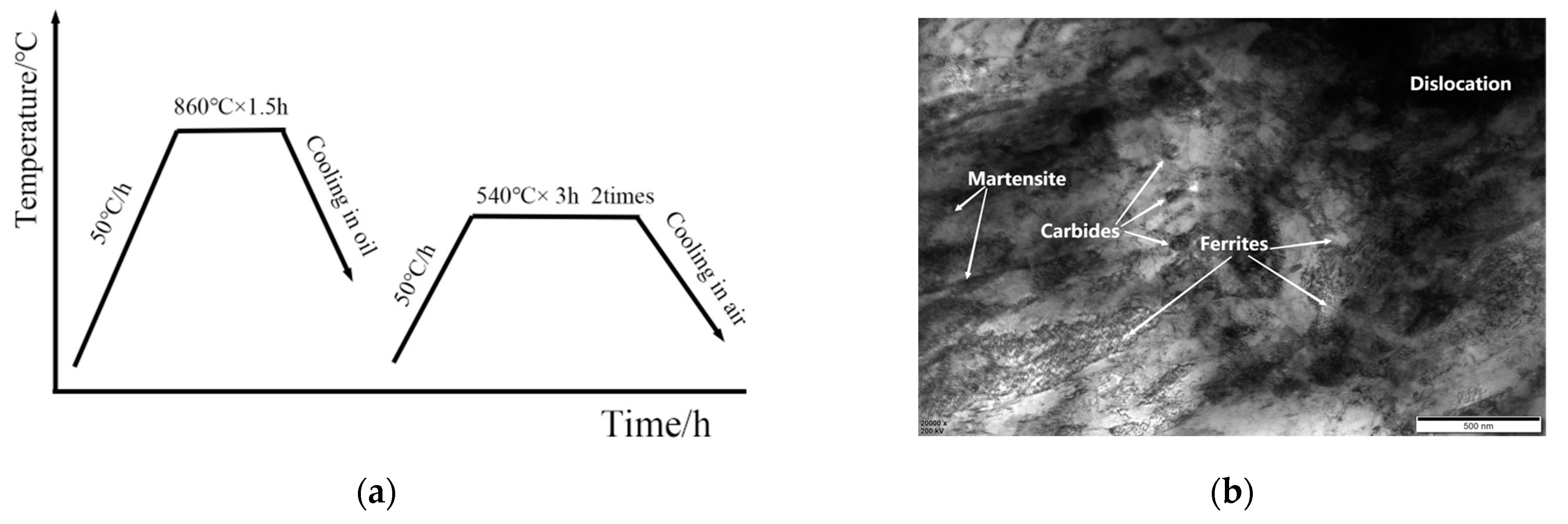

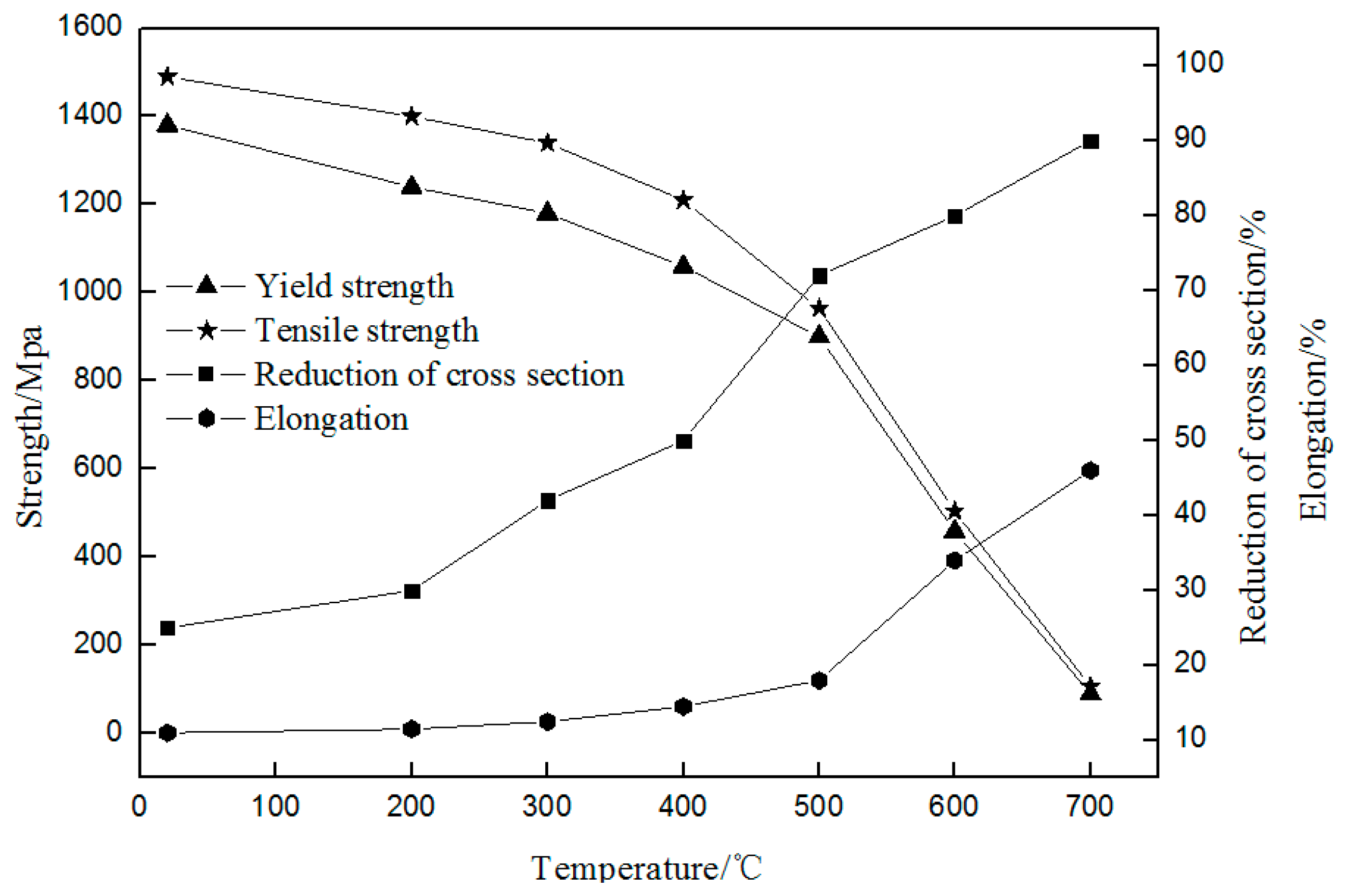
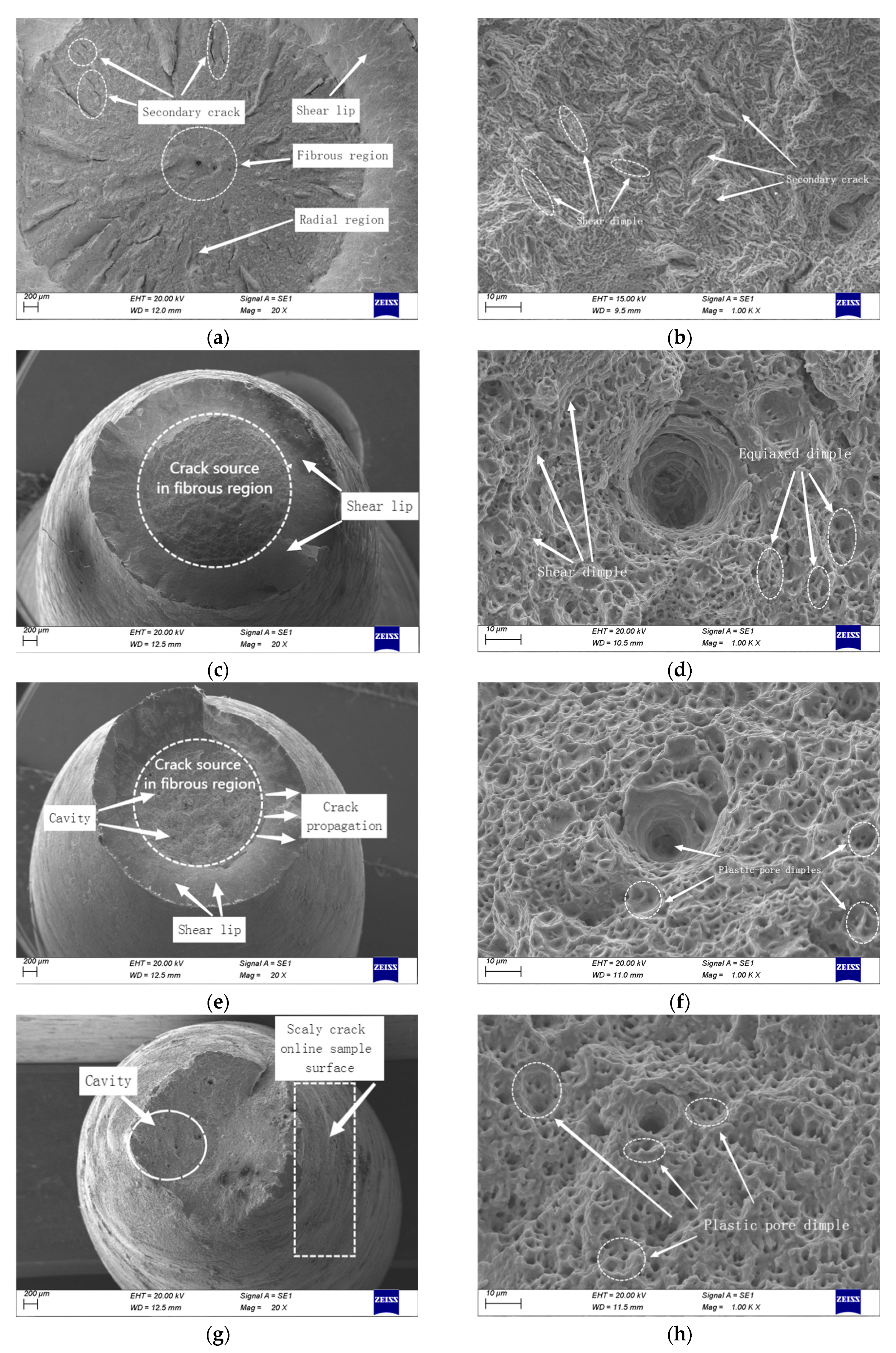

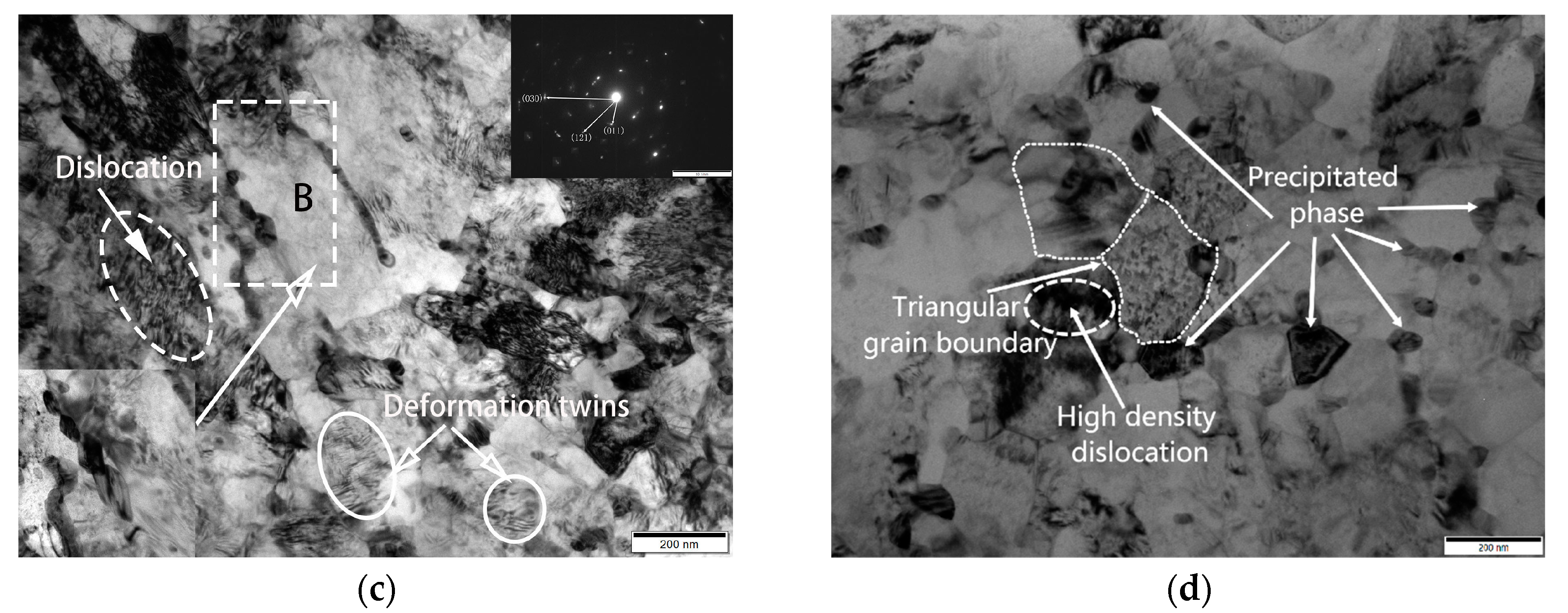

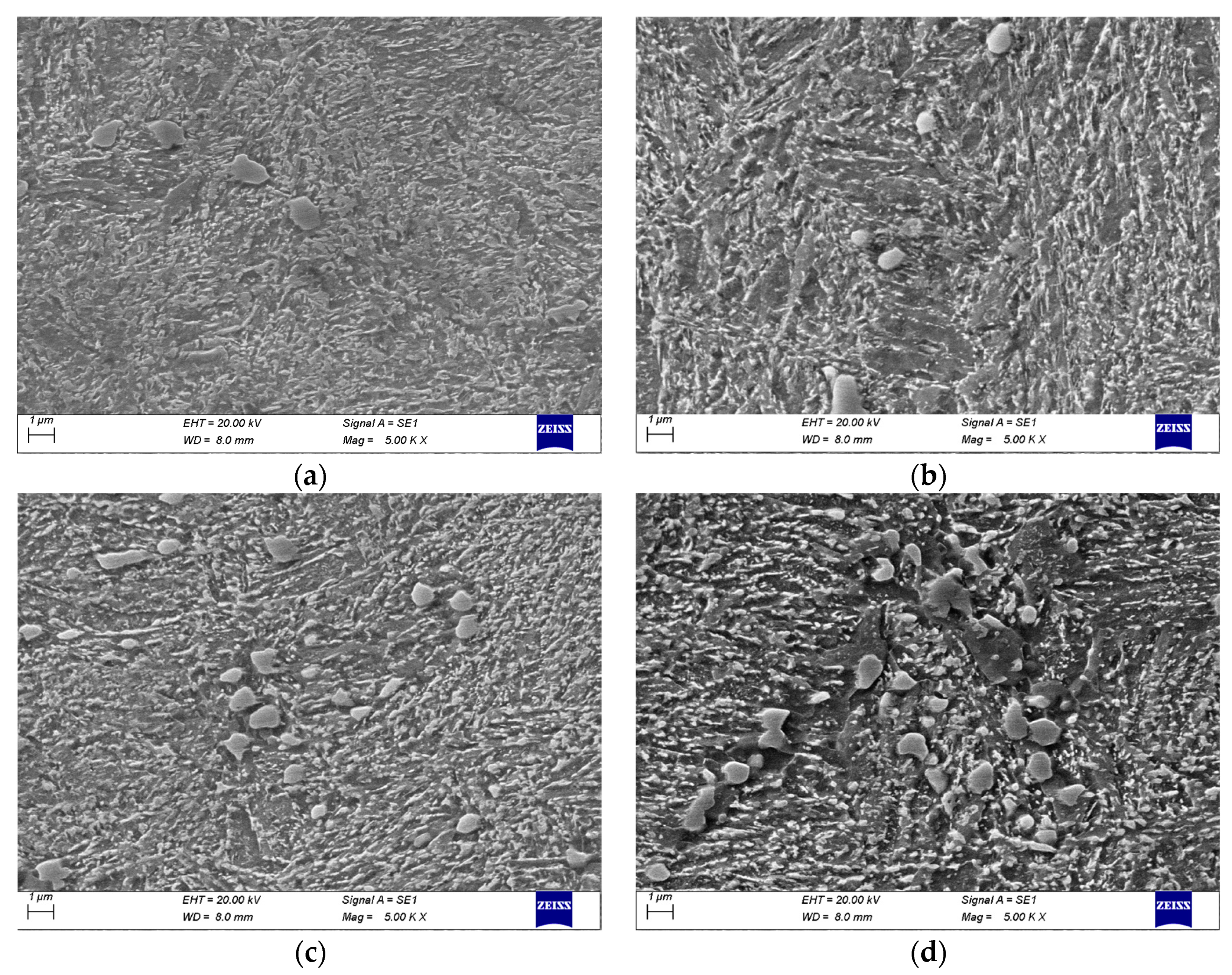
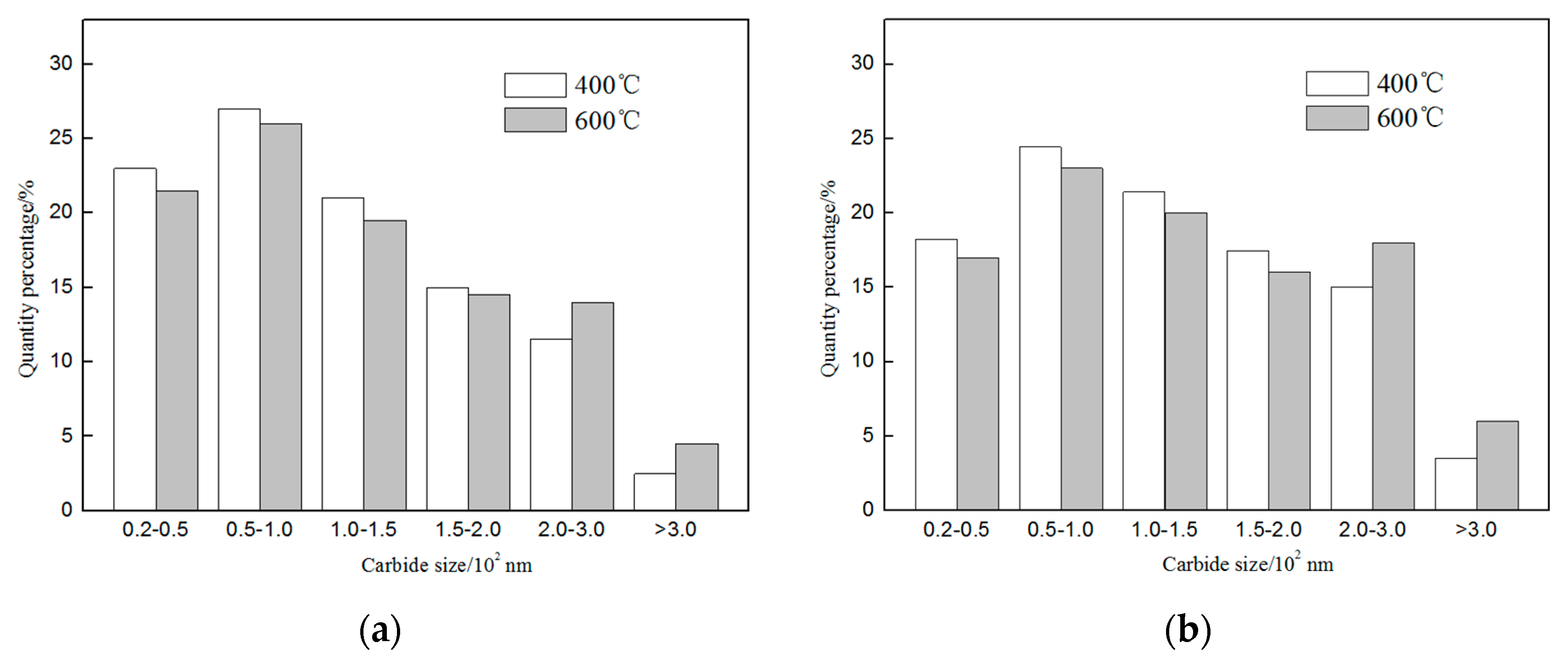
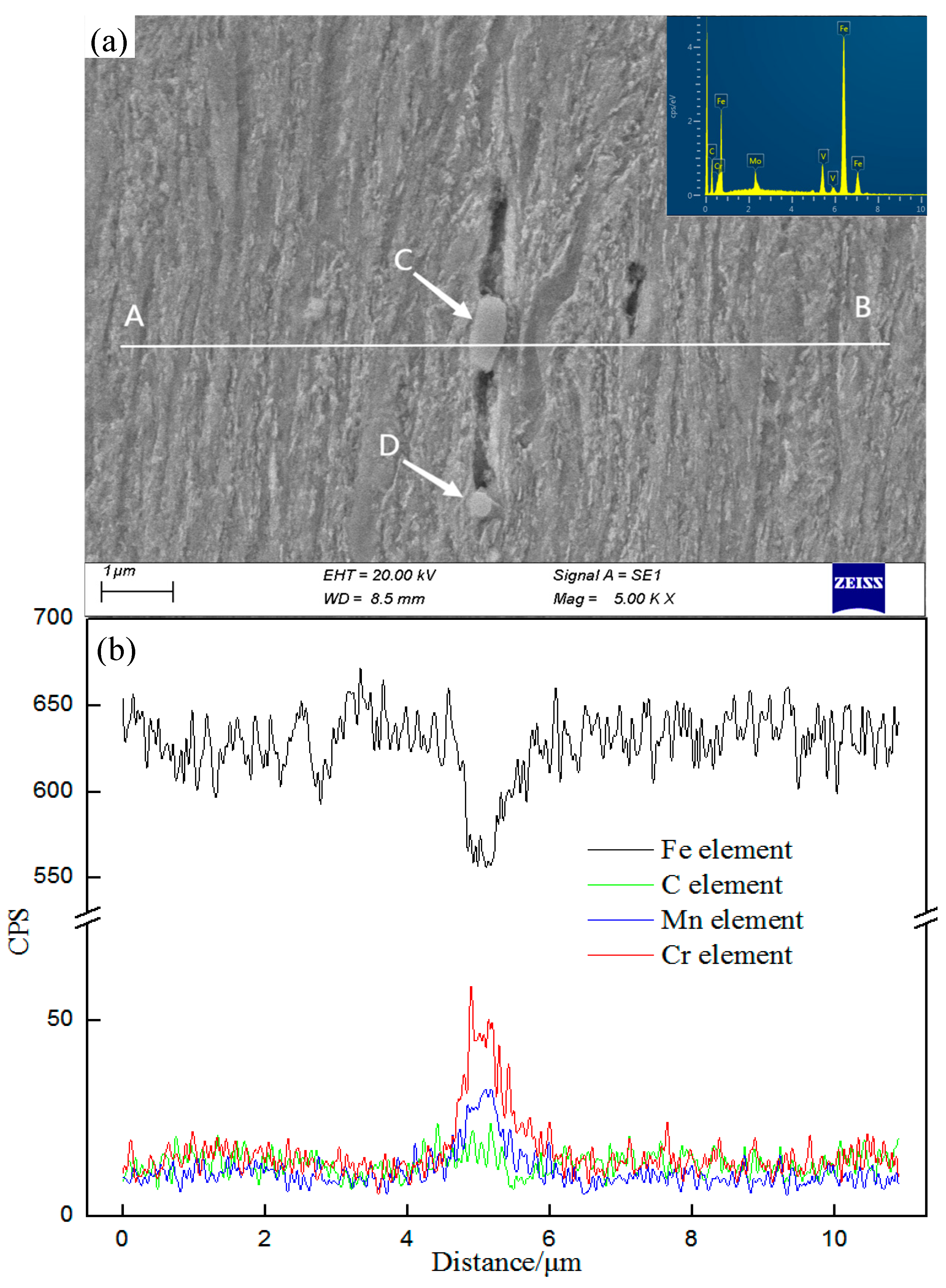
| C | Si | Mn | S | P | Cr | Ni | Mo | V |
|---|---|---|---|---|---|---|---|---|
| 0.56 | 0.20 | 0.81 | 0.0010 | 0.0065 | 1.15 | 1.78 | 0.52 | 0.10 |
| Tensile Temperature/°C | The Area of Fracture Crack Propagation Zone/mm2 | The Area of Crack Initiation Zone/mm2 | The Total Area/mm2 |
|---|---|---|---|
| Room temperature | 16.05 | 2.10 | 18.15 |
| 400 °C | 6.94 | 0.92 | 7.86 |
| 500 °C | 5.43 | 0.69 | 6.12 |
| 600 °C | 3.08 | 0.31 | 3.39 |
Disclaimer/Publisher’s Note: The statements, opinions and data contained in all publications are solely those of the individual author(s) and contributor(s) and not of MDPI and/or the editor(s). MDPI and/or the editor(s) disclaim responsibility for any injury to people or property resulting from any ideas, methods, instructions or products referred to in the content. |
© 2023 by the authors. Licensee MDPI, Basel, Switzerland. This article is an open access article distributed under the terms and conditions of the Creative Commons Attribution (CC BY) license (https://creativecommons.org/licenses/by/4.0/).
Share and Cite
Yuan, Y.; Wang, W.; Shi, R.; Zhang, Y.; Xie, J. Microstructure Evolution and Fracture Mechanism of 55NiCrMoV7 Hot-Working Die Steel during High-Temperature Tensile. Metals 2023, 13, 1056. https://doi.org/10.3390/met13061056
Yuan Y, Wang W, Shi R, Zhang Y, Xie J. Microstructure Evolution and Fracture Mechanism of 55NiCrMoV7 Hot-Working Die Steel during High-Temperature Tensile. Metals. 2023; 13(6):1056. https://doi.org/10.3390/met13061056
Chicago/Turabian StyleYuan, Yasha, Wenyan Wang, Ruxing Shi, Yudong Zhang, and Jingpei Xie. 2023. "Microstructure Evolution and Fracture Mechanism of 55NiCrMoV7 Hot-Working Die Steel during High-Temperature Tensile" Metals 13, no. 6: 1056. https://doi.org/10.3390/met13061056
APA StyleYuan, Y., Wang, W., Shi, R., Zhang, Y., & Xie, J. (2023). Microstructure Evolution and Fracture Mechanism of 55NiCrMoV7 Hot-Working Die Steel during High-Temperature Tensile. Metals, 13(6), 1056. https://doi.org/10.3390/met13061056




